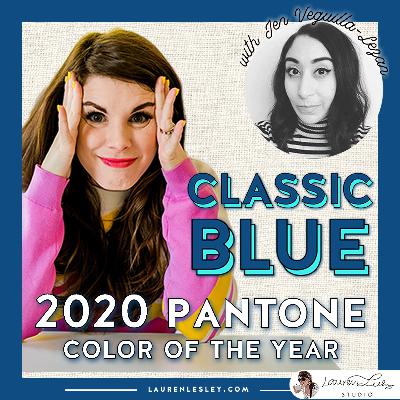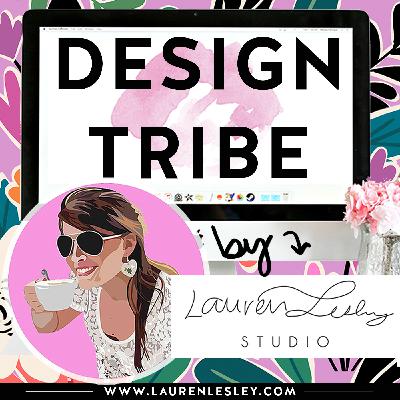Do These 6 Things BEFORE Jumping to a Full-Time Artist
Description
ART STYLE ACADEMY: https://www.laurenlesley.com/asa-sales-page-35-spots
DM me on Instagram: @LaurenLesleyStudio
Do These 6 Things BEFORE Going Full-Time as an Artist
Hey! How are you? If we haven’t met before, I’m Lauren.. I’m your host of the Design Tribe podcast, and I’m an artist and textile designer. In the last episode, I went into pretty great detail about what it was like working as a full-time artist and licensing surface pattern designs. So if you missed that episode, be sure to check it out.
I know a lot of you are either trying to make it as a surface pattern designer OR you dream of one day being able to leave your day job to license your artwork to companies.
I spent 2 years as an independent artist, and although there were many things I loved about working independently, I ultimately went back to an in-house job as a Senior Textile Designer.
A lot of these tips I’m about to share with you are things I WISH I did before making the leap to being a full-time artist. We’ll talk about all the money stuff in the very last tip so be sure to stick around for that juicy topic.
Okay, so my first tip is to…
- Publish a class to Skillshare.
- This might not be the advice you were expecting, haha!
- And to be honest, I’m a little annoyed with Skillshare, because last year they cut their teacher’s income by almost half - with no warning.
- From a business perspective, I understand if they needed to do this, but they really should have been up front about it and approached the cut in a much more gradual way. So, it felt really crappy.. Especially when a lot of teachers relied on this as a dependable stream of income.
- BUT!
- The reason my first tip is to upload a class to Skillshare is because when you go full-time as an artist, you will need some recurring revenue coming in on a regular basis.
- When it comes to teaching, Skillshare is one of the easiest places to start, because they already have such a great built-in audience with lots of students who are creative.
- Domestika is another popular teaching platform you could choose if Skillshare has lost your trust. I haven’t personally uploaded classes to Domestika so I can’t comment on whether I like the platform or not, but other artists seem to really like it.
- Another reason to upload a class is to just get your feet wet and see if you enjoy teaching.
- A lot of full-time artists teach on a platform like Skillshare or sell a course as a way to supplement their licensing income, which if you’ve ever done any licensing, you know very well it can fluctuate a lot!
- Your first class doesn’t even have to be related to what you WANT to do moving forward. It’s easy to think: “Well, I can’t teach about that, because I don’t have enough experience yet.” And you would be right!
- Instead, think about where you were 5-10 years ago. What have you learned since then?
- Your course could be about learning how to use Photoshop or how to draw a Still Life. What are some things you learned in school that you could teach? What did you major in? It doesn’t even have to be art-related!
- It does help to keep your class topics related in the long term, but for your very first class - it could really be anything.
- The idea is for you to discover A.) if you enjoy teaching - e.i. Filming yourself, doing a little video editing, etc. and B.) to start generating some recurring revenue.
- Develop your Art Style
- When you’re working as an in-house designer, it can be really hard to find your own Art Style.
- Often when we work an in-house job, you get really good at doing ANY style… depending on what the project needs.
- Companies often try to fill out the white space in their line by covering a range of styles from traditional to modern to boho, you name it. That means, as the designer, you develop the skill of designing ANY style.
- The problem with that is… you start to lose a sense of your own style and who you are from the inside out.
- You might get excited by new trends or a new project that changes things up. When you like soo many different things, it can be really hard to narrow down to just ONE look. Especially, when you don’t know what’s going to sell or which style might be the most reasonable to pursue.
- When you can do any style, HOW do you pick?!
- This gets very tricky, because in LICENSING… companies are really only interested in licensing when your art brings something new to the table… something that they don’t already have from their own in-house designers.
- Companies want to know what YOUR perspective is.
- Think of the Jungalow brand.
- Justina Blakeney brought a brand new perspective to home décor by covering her house in an explosion of plants and colorful textiles.
- In a time where Minimalism and white sofas were extremely popular, she did the opposite thing… and by staying true to her own vision, this Boho Maximalism style exploded.
- Think of Rifle Paper Co. and the unique style of Anna Bond’s florals.
- She brought a brand new look to florals that really highlights her own unique style that’s painterly, colorful, and friendly.
- Oftentimes, companies want to license work that’s the same, but different. This means the subject matter is often the same… like the florals that are so famous from Rifle Paper Co. But the WAY Anna Bond painted them was so different.
- Style is all about technique.
- If this is something you’re struggling with, I do offer a self-paced online program called Art Style Academy. When you go through my program and do the work, you will develop your own style by the end of the course. If this sounds interesting to you, you can check out the link in the show notes or check out my website at LaurenLesley.com - and Lesley is spelled with an E-Y.
- Create a Portfolio with a Large Body of Work
- Once you’ve developed your Art Style, the next area of focus is to build out your portfolio. It will be sooo much easier to get the ball rolling if you already have a full portfolio to sell.
- From there, you can decide if you want to work with an agent, upload to an on-demand site, or exhibit at a tradeshow.
- So, you might be wondering… “Okay, but how many pieces do I need to have in my portfolio?”
- Honestly, you probably need close to 100 pieces in your portfolio. I know this sounds like a lot, but it’s important to work in collections and some of these could be coordinates. For each collection, you also need to work in a limited color palette and make sure your pieces are looking related to each other.
- If you are cold-emailing Art Directors, you don’t necessarily need 100 pieces to start. You can pitch collection-by-collection.
- But if you’re investing a lot of time, money, and energy to exhibit at a tradeshow, I recommend going in prepared with A LOT of work. You’re more likely to gain contracts if you have a collection that really resonates with a client.
- Okay, so what else?
- Start uploading to ONE On-Demand Site
- Etsy
- Society 6
- Spoonflower
- Creative Market
- Patternbank
- Minted
- Uploading to On-Demand sites can be a bit tricky for a lot of reasons. I feel like that might be another whole podcast episode.
- But I think a lot of artists try uploading to one site, find that they’re not having success so then they switch and try a different site.
- A lot of time gets wasted posting and re-posting your designs on so many different sites.
- I think it’s important to figure out WHICH site you like the best up front - before you quit your day job. Figure out which site is converting to sales.
- For example, my Character Builders sold really well on Creative Market. Customers on Creative Market are usually other designers and they understand how to use programs like Illustrator. They buy these products to save themselves a little time.
- However, when I tried to sell the same designs as Clip Art on Etsy it didn’t do very wel








